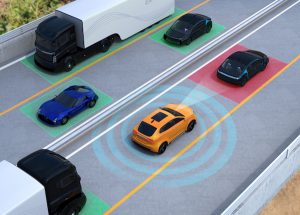New and expanding ideas of how we look at things is growing almost at an exponential pace. Engineers, scientists and designers are always looking for ways to see things we’ve never seen before. One piece of this emerging technology is what’s known as Time-of-Flight (ToF) cameras.
The easiest way of thinking about Time-of-Flight is in relationship to a sonar system – except that it uses light rather than sound to detect things.
ToF cameras are becoming a common feature on industrial robots and drones. Also known as depth cameras, they map out their surroundings by creating a basic three-dimensional representation of what is in front of them. They are highly accurate for distance mapping, and 3D imaging technology. The sensors emit a very short infrared light pulse and each pixel of the camera sensor measures the return time. Flash Time-of-Flight cameras have a greater advantage over other technologies, as it has the ability to measure the distances within a complete scene in a single shot.
A time-of-flight camera has an imaging sensor in much the same way as a normal digital camera. But the job of each photosite on the CCD sensor is to measure the time it takes for a beam of infrared light fired from the camera to return to the camera – after it reflects off the objects in the scene in front of it.
A few examples of how Time-of-Flight cameras can be used include:
- Object scanning
- Measuring distance
- Indoor navigation
- Obstacle avoidance
- Gesture recognition
- Tracking objects
- Measuring volume
- Reactive altimeters
- 3D photography
- Augmented reality
At Universe Optics we offer a wide range of CCD lenses for use in Time-of-Flight cameras. Additionally, we will work with your developers to design and craft a precision lens that best suits your needs.
ToF is one of the few techniques known as range imaging. (Range imaging is the name for a collection of techniques that are used to produce a 2D image that shows the distance to points in a scene from yet a specific point, normally one associated with some other type of sensing device.) The sensor device, which is used to produce the range image is often referred to as a ‘range camera’. Other range techniques include sheet of light triangulation, structured light, interferometry and coded aperture, and stereo triangulation.
Range imaging ToF cameras are highly advanced LiDar systems, which replace the standard point by point laser beams with a single light pulse or flash to achieve full spatial awareness. They can sense the time in which it takes light to return from any surrounding objects, combine it with video data and create real time 3D images.
The camera can be used on a drone or a car to help it avoid obstacles. Another application that ToF can be used for is identifying a subject or for gesture recognition. ToF can be used for security applications – helping to identify the user – or simply, perhaps, telling the difference between the neighbor’s cat and a human intruder.
In the workplace, ToF sensors and cameras are sold as components. As a result, they can, for instance, be used on production lines by robots to pick the right component, or to spot faulty goods.
With such a wide variety of applications, ToF sensors and cameras have the potential to become standard parts of newer imaging systems as the technology continues to advance. We can help you stay on the cutting edge of all your imaging needs.